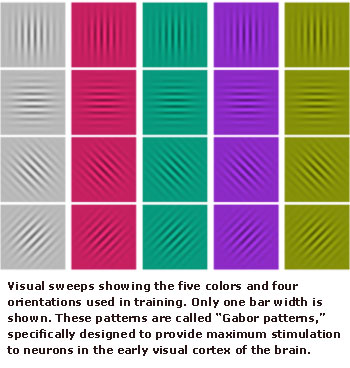![]() Imagine you are participating in a tennis match and your opponent serves you the ball. Your visual processing speed will partly determine your ability to return the ball. The quicker you can identify the ball and determine its trajectory, the faster you can put yourself in the appropriate position to hit the ball back over the net.
Imagine you are participating in a tennis match and your opponent serves you the ball. Your visual processing speed will partly determine your ability to return the ball. The quicker you can identify the ball and determine its trajectory, the faster you can put yourself in the appropriate position to hit the ball back over the net.
Our Visual Sweeps exercise is designed to help you with these quick moving scenarios by speeding up your visual processing so that you receive more information faster and more precisely. This increase of speed to your visual processing helps create a clearer picture in your mind so you can react more quickly in the moment and also recall visual events more effectively at a later time.

While training with the Visual Sweeps exercise, you will observe bars in motion – what we refer to as ‘spatial frequency sweeps’. You’ll need to identify whether each spatial frequency sweeps outward or inward. Although it may not be obvious to us, everything contained in these sweeps, when broken down to its basic elements, is constructed of the basic visual information including colour, orientation, luminance, and spatial frequency. We will be able to improve our overall visual acuity if we can help our brains easily identify these sweeps at very quick speeds.
Different nerve cells in our brain (i.e. neurons) are activated by different types of sweeps. One set of neurons might, for example, react to vertical motion while a different set of neurons reacts to horizontal motion.
In order to exercise the highest number of neurons possible the Visual Sweeps exercise will change in a variety of ways:
- Five different colours of sweeps (combined with various degrees of luminance) that have been carefully chosen for maximum neural response.
- Four unique sweep orientations including two diagonal, vertical and horizontal.
- Changing spatial frequency with bars within the sweeps growing thinner and thicker.
As you practice and improve you’ll find that the sweeps will push your brain to speed up by gradually speeding up themselves.






 English
English
 Français
Français


